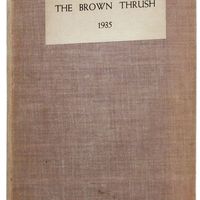-
Title
-
Brown Thrush: Anthology of Verse by Negro Students
-
Uniform title
-
Brown Thrush
-
This edition
-
"The Brown Thrush: Anthology of Verse by Negro Students." Ed. Lillian Voorhees and Robert W. O'Brien. Bryn Athyn, PA: Lawson-Roberts Publishing, 1932. 67 pp.+2 page index.
-
Other editions, reprints, and translations
-
● Reprint: Freeport, NY: Books for Libraries Press, 1973. (The Black Heritage Library Collection)
-
Table of contents
-
N/A but includes the following:
● J. Henderson Brooks / The Last Quarter Moon of the Dying Year
● J. Henderson Brooks / The Gulf
● J. Henderson Brooks / The Caucasian
● Lucy Ariel Williams / Glory
● Doretta Lowery / The Wind
● Charles E. Burbridge / Amateur Night
● T. Thelma Clements / A Crimson Rose
● Delmar Bobo / Beauty
● "some of the authors include J. Henderson Brooks (main author with 16 entries), Arlene Benton, Elaine Bethel, Delmar Bobo, Ethel Brown, Lillian Brown, Charles Burbridge, Thelma Clement, Gertrude Davenport, Julia Gaillard, Leonidas Gibbs, William Greene, Erskine Hayes, Ketherine Hunter, Oliva Hunter, Audrey Johnson,Katie Kelly, Milas Love, Doretta Lowrey, Portia Lucas, Blanche Nivens, Herbert Pickett, Hilda Preer, V.A. Reese, Alice Robinson, Curtis Smith, Harold Taylor, Eleanor Thompson, Theresa Thorpe, Edna Mae Weiss, and Lucy Williams"
-
About the anthology
-
● Lillian Welch Voorhees, the co-editor of the volume and of the second "Brown Thrush" collection, was a white interlocutor with African American culture: "She earned her bachelor of arts from Mount Holyoke College and her master of arts and doctorate at Columbia University, writing her master's thesis on African American drama. As a white woman, she spent her entire career in the dramatic arts at historically black colleges and universities (HBCUs), beginning first as a 'missionary.' She later became a civil rights advocate, championed integration, and spent much of her time living within the black community. Collections of her papers are archived at Fisk University, Amistad Research Center [Tulane University], and Ohio State Historical Society" (Simmons 2017: 459n.4).
-
Reviews and notices of anthology
-
● "E. R." "New Books." Review of "The Brown Thrush." "The New York Amsterdam News" 29 June 1932: col. 4.
"This name for such a volume of verse is a happy one, for it indicates a poetic effort not too ambitious, but full of lyric quality. So far as I know it is the first collection of verse by Negro students and with its illustrations by Gwendolyn Bennett, themselves full of lyric beauty, it makes a lovely volume and one of which to be proud.
"As one might expect, the work is uneven in literary quality, but the highest note is very high indeed. 'The last quarter moon of the dying year,' by G. Henderson Brooke [sic, J. Henderson Brooks], is to me one of the loveliest poetic bits I have seen in many a long day. Its few lines etch a picture of breath-taking beauty, and at the same time express a noble sentiment. All of this poet's lines are rich with emotion or with thought, and he writes in the classical tradition to which he is evidently sympathetic. We shall hear more of him.
"So we shall of Lucy Ariel Williams, who knows how to express strong emotion with an admirable restraint, as witness her moving lines called 'Glory.' Miss Williams has also imagination and an original turn of expression. Her 'Northboun'' is already known to many.
"I like, too, several bits which paint a picture or strike a mood. Such are 'The Wind,' by [?] Doretta Lowery; 'Amateur Night,' by Charles E. Burbridge; 'A Crimson Rose,' by T. Thelma Clement; and 'Beauty,' by Delmar Bobo.
"Race feeling is not absent from this volume, although it is but one of many moods, of many emotions and mental interests. Of the poems which are inspired by racial feeling, one of the most mature and moving is Mr. Brooke's [sic, Brooks's] 'The Gulf.' 'The Caucasian,' by the same author, strikes a note of deep moral indignation.
"Altogether this is an interesting and charming collection of verse, which, we hope, will be only the first of many such appearances." [full text of review]
-
● Ovington, Mary White. "Little Complaint in Verse in 'The Brown Thrush.'" Review of "The Brown Thrush." "Norfolk Journal and Guide" 21 Jan. 1933: 6, col. 7.
"'The Brown Thrush' is an anthology limited to verse written by undergraduates and recent graduates of Tougaloo and Talladega colleges and edited by Lilian W. Voorhees and Robert W. Obrien [sic]. Its field is small, and like many other anthologies, much of mediocre worth is included, but even where the verse is slight, crude, it has charm. There is faith in it, and courage, and little of affectation. It is like its title, 'The Brown Thrush,' an assuming [sic] bird.
"The verse of J. Henderson Brooks dominates the book. This graduate, who was late entering college, has lived more years than the others and has sung larger audiences. Next Williams with 'Northbound,' that
O! de wurl' ain't flat,
An' de wurl' ain't roun'
Hit's one long strip
Hangin' up an' down--
Jes' Souf an' Norf;
Jes' Norf an' Souf.
"Olivia Hunter has hit off the loquacious robin better than anyone else whom I remember. The rose whispers to the robin that spring is here,
The robin who could never keep a thing;
Opened wide his mouth and began to sing,
"Spring is here, spring is here!"
"There is much seriousness in the book, but little complaint. It shows the college youth in these far southern schools, at least the writers of verse, in a glowing twilight, like the thrush singing on the top of the spruce tree, with uplifted head, beak pointed toward the skies.
"'Brown Thrush' is published by Lillian W. Voorhees, Talladega College. $1.00. Reviewed by Mary White Ovington, treasurer of the N.A.A.C.P." [full text of review]
-
● "Talladega College Has Endowment Fund Nearing Million." "The Chicago Defender" 11 June 1932: 5, col. 2:
"Apart from the study of literature actual creative work is done by students in both prose and poetry. This month a book of poems by students at Talladega and Tougaloo colleges will be published. This little book will bear the title of 'The Brown Thrush.'"
-
Commentary on anthology
-
● Alice Dunbar Nelson, letter to Lillian W. Voorhees (5 May 1932): commenting on the anthology, Dunbar Nelson remarks: ""The Brown Thrush" is unique. Its song is lovely, like the first notes of a young bird, trying its voice, and promising a louder and more sustained song in the future" (quoted in Simmons 2017: 450).
-
● Countee Cullen, letter to Robert W. O'Brien (13 April 1932): Cullen mentions his favorite writers and remarks: ""The Brown Thrush" augurs well for the future of the Negro poet"; the anthology is "an encouraging expression of poetry from young Negro collegians and is a definite indication that there is a crop of new Negro poets in the making" (quoted in Simmons 2017: 450-51).
-
● Benjamin Brawley, in an article on "The Promise of Negro Literature" in the "Journal of Negro History" 19.1 (1934): 53-59, remarks that "the spirit of experimentation is abroad in the land. At our colleges there has recently been much interest in the original Negro drama. Just a year ago I received a copy of a little book, 'The Brown Thrush,' made up of poems by the students at Talladega and Tougaloo Colleges. Similar efforts have been put forth by groups in Cleveland, in Boston, and elsewhere. At both Howard and Fisk there are now courses intended to encourage creative writing" (57).
-
● John S. Lash, in "Dimension in Racial Experience: A Critical Summary of Literature by and About Negroes in 1958" ("Phylon Quarterly" 20.2 [1959]: 115-31), looks back on this anthology as an early and immature product, while commenting on contemporary work in 1958: "Mr. Joseph's poetry in 'A Living Expression' is essentially college verse which recalls the days of 'The Brown Thrush' and other anthologies of undergraduate effusion. The young poet has learned the uses of versification and has been impressed with the efficacy of romantic figures of speech. He tends, however, to confuse what is merely painted with what is genuinely colorful in experience: he immerses his verse in the adjectival, rather than in the nominative and predicative significance which is so essential a part of the mature poetic impulse. Mr. Joseph's conceptions in poetry . . . are almost quaintly academic and ritualistic, so that his book suggests advanced drill work in the mechanics of a literary form. And poetry among Negro writers remains in limbo" (125).
-
See also
-
● Jonathan Henderson Brooks Collection. University of Mississippi Libraries.
Includes correspondence between Brooks and Voorhees around "The Brown Thrush" [vol. 2?] (1 Jan. 1935, 22 March 1935).
-
University of Mississippi
-
● Lillian Welch Voorhees Papers, Amistad Research Center. Tulane University.
Includes "advertising, correspondence, proof sheets, plays and poems, relating to "The Brown Thrush: Anthology of Verse by Negro Students" of which she was co-editor [1st ed., 1932; 2nd ed., 1935]."
-
Amistad Research Center. Tulane University
-
● Simmons, LaKisha Michelle. "The Poetry of Vesta Stephens: In Search of Black Girls' Gardens." "Tulsa Studies in Women's Literature" 36.2 (Fall 2017): 449-61.
-
● A copy of the book for sale from Barry's Books (Santa Rosa, CA) includes an undated letter from Jonathan Henderson Brooks (1904 [or 1905]-1945) (the main poet featured in the volume) to Homer T. Larson (most likely a former teacher at the school attended by Brooks, which was Tougaloo College, from which Brooks graduated in 1930): "My dear Mr. Larsen: As I live here day-by-day I am coming to see the significance of you in my life. I have never thought it advisable to write an open letter to a teacher before, but for sometime I have wanted to tell you of your influence on my life. The two courses I have taken from you have meant an unspeakable deepening of my life. I leave each little division with a subtle sense of having achieved another story of the great skycrapper (meant to say skyscrapper!) which you, the artist are helping me build. Each new division, therefore, becomes powerfully significant in my life, and I have a true innate feeling that what is gained from you is like a well from which I shall be able to draw the longest day I live. I make it a happy habit to talk with God sometime until the tears roll down, hence forth in those solemn moments, I shall thank him for you. Pardon me if I have acted naively. Take it from me- I mean everything I have said. I am faithfully yours, Jonathan H. Brooks"
-
Abe Books (from Barry's Books)
-
"Brooks's poems appeared in publications such as The Bronzeman, The Crisis, The Canadian Student, The Congetionalist, The Kaleidoscope, The Lyric, The Northern Light, Opportunity: A Journal of Negro Life, and The World Tomorrow. Another poem by Brooks was published with the permission of Harper and Brothers along with COUNTEE CULLEN [i.e., from an anthology edited by Cullen and published by Harper]."
-
 Brown Thrush: An Anthology of Verse by Negro Students. Vol. 2
Brown Thrush: An Anthology of Verse by Negro Students. Vol. 2
-
 Silhouettes of Life
Silhouettes of Life
-
Cited in
-
● Jahn 1965: 217 (no. 2212).
● [not in Kinnamon]
-
Item Number
-
A0508a
 Brown Thrush: An Anthology of Verse by Negro Students. Vol. 2
Brown Thrush: An Anthology of Verse by Negro Students. Vol. 2
 Silhouettes of Life
Silhouettes of Life
 No image available
No image available Brown Thrush: An Anthology of Verse by Negro Students. Vol. 2
Brown Thrush: An Anthology of Verse by Negro Students. Vol. 2 Silhouettes of Life
Silhouettes of Life